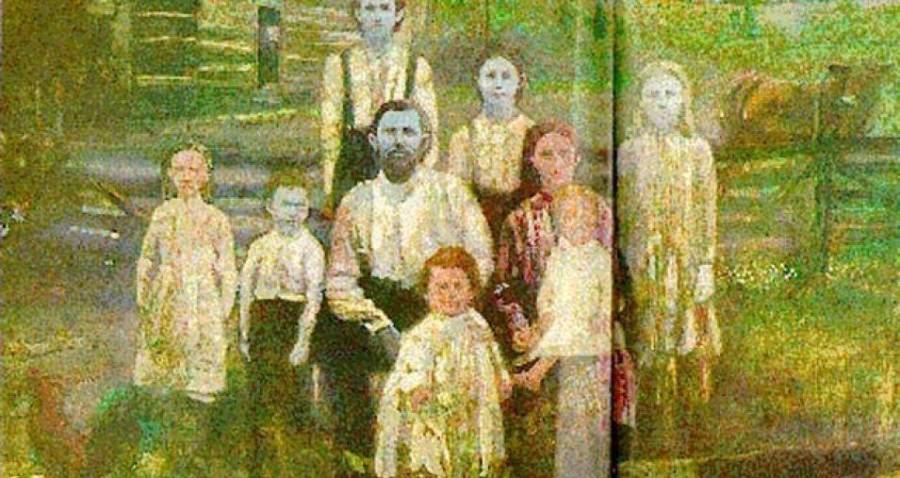Last updated on January 25th, 2023 at 04:20 am
There are dozens of well-known fictional characters with blue skin, from Watchmen’s Dr. Manhattan to X-men’s Beast to Neytiri in Avatar.
Real people, though? They don’t tend to come in blue. Or do they?
In reality, the Fugates family of Eastern Kentucky, particularly those alive in the early to mid-20th century, were born with blue skin.
Our story began in 1820 when Martin Fugate and his wife, Elizabeth Smith, settled in Troublesome Creek, an out-of-the-way part of Appalachia in Kentucky.
According to some stories Martin Fugate, a French orphan, was blue himself, but this is unconfirmed. We know that his firstborn, Zachariah, was born blue, along with three others of their seven children.
Because their community was isolated, few people, except their neighbors, knew about this strange blue family.
Why were the Fugates Blue?
The Fugates family had an extremely rare genetic defect that caused methemoglobinemia. This condition resulted in their blood not carrying as much oxygen as someone without it.
As a result, their blood is darker, making the skin of Caucasians look blue and their lips look purple.
Methemoglobinemia can cause seizures and developmental delays, but the Fugates dodged a bullet there. Despite their intensely blue skin, there are no reported cases of Fugates suffering adverse side effects.

Because a recessive gene caused the condition, it likely would have faded away over the years. But unfortunately, inbreeding ensured it would stick around for a long time.
The Fugates lived in isolation in an area with no railroads and few regular roads. As a result, most Fugates had little choice but to marry cousins and other family members that lived nearby.
Some of the other family branches that married in were the Stacys, the Smiths, The Richies, and the Combs.
So let’s take Zachariah Fugate, for example. He married his aunt. One of his children married a cousin. One of their children married their cousin, and so on.
Treating the Blue Fugates
After living in relative obscurity for a century, the Fugates came to the attention of Dr. Madison Cawin, a hematologist at the University of Kentucky.
Curious from what second-hand information he had heard, Cawein set out to the hills of Kentucky, wanting to learn more about the Fugates. He met Ruth Pendergrass, a nurse who had treated a Fugate before in his search.
A blue woman requested a blood test while Pendergrass was working for the County Health Department, giving her a proper scare. She assumed the woman was having a heart attack.
The woman introduced herself as a member of the Combs family from Ball Creek. It turned out her sister was a Fugate.
After Pendergrass joined Cawein, it didn’t take them long to find the Fugates. After interviewing some family members, Cawein concluded that their blood must be missing an enzyme that helps blood work normally.
The solution was surprisingly simple. Cawein injected them with methylene blue, a dye.
It seems counterintuitive to inject someone with blue dye to treat a condition that makes their skin blue, but it worked. The cosmetic changes were extremely quick.
The effects were temporary, but with methylene blue tablets, they could maintain the treatment’s effects indefinitely.
According to Cawein, the Fugates he treated were immediately thrilled as the blue faded away. But, for them, blue skin was a stigma.
Neighbors were kind to people they saw as different, so the family withdrew from the rest of their small community.
When Cawein treated them, it was apparent how the family felt like outcasts. As a result, they rarely seek treatment or interact with the outside world, making the inbreeding even worse.
The Modern-Day Fugates
Over the decades after Cawein’s treatment, the Fugates had large families, and some of their children were born blue. But, as their community grew, so did the gene pool. The recessive gene faded away as Fugates married outside of their family.
In 1975, the last Fugate with blue skin was born. Benjy Stacy was born an almost purple color. The doctor was so alarmed that the doctor ordered a blood transfusion.
His grandmother explained the family’s strange lineage, which led the doctors to conclude he inherited the rare condition.
The blue naturally faded over the next couple of weeks, though his lips and nails would become purple in the cold.
Today, the Fugate family isn’t very candid about the history of inbreeding and their strange genetics. In 2012, ABC News published a story about the Fugates family but was unable to speak with the family directly.
Despite the lack of content, at least one Fugate descendant still lives in that part of Kentucky.
Will there ever be more Blue Fugates?
With inbreeding off the table, it’s unlikely we’ll ever see a new blue Fugate. Without that, it’s infrequent for the recessive gene that caused the condition to appear.
However, it still exists among many family members. So if they marry someone else with the recessive gene, it could appear again on the off chance.

